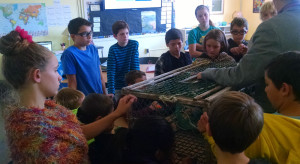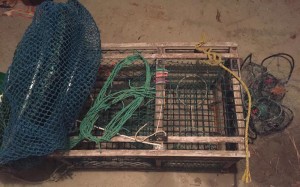I’ve had the privilege of connecting with various organizations on the front lines of fisheries issues, including Cape Ann Fresh Catch, Northwest Atlantic Marine Alliance, Gulf of Maine Research Institute, and others. I’ve recently been working with Slow Fish, the fisheries movement under the Slow Food organization, aimed at ensuring fair, affordable, local and sustainable seafood. As part of the promotion to shine a light on Slow Fish 2016, Gateway to the Americas (March 10-13) several people are blogging about their fisheries experiences.
Here is the blog I wrote about sustainable seafood education, including some of the observations I’ve made from my classroom experiences.
Sparking Change, One Sustainable Seafood Class at a Time
I did my best to look confident as I sat down at the table with a bunch of 9th graders clutching their iPads. Inside, butterflies were doing the tango. What was I doing here?
I’d been asked to serve as an expert, listening to students’ sustainability projects, called expeditions, at the Casco Bay High School in Portland, Maine. My role was to provide feedback on topic choice, resource selection and content. I’d been writing about sustainable seafood for four years, diving into important issues like bycatch, international fisheries management, aquaculture, eco labeling, etc. But I’d only had a smattering of teaching experience, and I wasn’t really sure if I could help these students.
Then the first student delivered a well-thought-out overview of the collapse of the Northern shrimp fishery in Maine. He’d done much of the same research I had, and had come to many of the same conclusions about the potential negative effects of water temperature increases, and decreases in the phytoplankton the shrimp eat.
I was amazed. At that instant, I realized high school and even middle-school students are at a good age to begin learning about the issues around sustainable seafood. If students can not only engage with the topic, but also care enough to seek solutions, there’s hope for the future of marine ecosystems. Why not bring that message directly into classrooms?
That was two years ago. In the interim, I became involved with movements like Slow Fish because I shared similar views on responsible fisheries. I’ve worked with the team planning Slow Fish 2016 messaging strategies, and look forward to continued collaboration on Slow Fish messages and events.

This is “hands-on” education.
I also launched a non-profit specifically aimed at discussing with middle- and high-school students some of the most important issues about how seafood gets from boat or farm to plate. One Fish Foundation teaches students to think about seafood not just as frozen fish sticks, but as a precious resource delivered via an often complex system. In one or two classroom visits, we talk about the delicate ecological and environmental balance between healthy fish populations, harvest, anthropogenic impacts, changing ecosystems and local economies.
I’ve worked with students aged four through 15. I brought a lobster trap and a turtle excluder device into my daughter’s pre-kindergarten class, and managed to hold their attention for half an hour. We talked about how we catch lobsters and some fish, and what we’re doing to protect the species. I’ve discussed in broad strokes some of the complexity of international fisheries management with 9th graders, and brought a dead fish into a 6th grade science class to discuss invasive species.
In every class, there’s been a moment when I see comprehension set in as students’ eyes light up and they raise their hands to ask a question or make a comment. They begin to see where the natural balance is or should be, and how we can tip that balance for the worse or the better.
Here are a few of the observations I’ve made in the past several months:
- Age is irrelevant. One Fish Foundation lesson plans are customized to meet students where they are in their classroom curricula. So I was able to get a bunch of pre-schoolers to understand that we don’t kill every lobster or fish we haul out of the ocean, and why that’s important. Starting the conversation early gets students to think about that balance. The older the student, the more they start to think in terms of solutions.
- Students are better served by having enough information to make their own decisions when at a restaurant or seafood store. There are plenty enough static buying guides available. I’ve found students more receptive to understanding why some fisheries are more sustainable than others. My 6th graders now ask specific questions about when, where and how fish or shellfish was caught or grown.
- Visual and hands-on props are crucial. Despite the fact the dead black sea bass was rather pungent, students crowded around the desk and begged to touch the pharyngeal plates (crushing plates in the throat). My daughter used a stuffed turtle as a prop to show how a turtle can escape certain nets.
- Coastal communities where seafood is abundant are great launching points for these kinds of discussions with students. Portland, Maine area students in general love seafood, and are receptive to talking about where it comes from.
- Enthusiasm for the topic can be contagious. This is a standard teaching tenet, but made more relevant by the fact that we’re talking about food. Ten- and eleven-year olds in particular seem to be at the beginning threshold where they start to care about how food gets on their plates. Slow Fish 2016 will bring enthusiasm to community discussions about seafood issues, including the importance of youth involvement.

Tools of the trade.
Perhaps the most important take-away for me has been that given the information and the right impetus, some of these students may be future catalysts of change. When an 11-year-old says she told her mom not to buy shrimp at a restaurant because the waiter said it was from Thailand, I feel I’ve succeeded.
I’ve had conversations with 9th graders about the importance of community supported fisheries (CSF) in ensuring fresh, locally caught seafood while supporting local fishermen. Similar to buying shares with a CSA (community support agriculture), people buy shares of future fresh caught fish. Some CSFs, like Cape Ann Fresh Catch, focus on underutilized (read: abundant) species. Those students talked about ways to start a new CSF in their expedition projects.
When I tell people I’m bringing these messages into classrooms, they invariably tell me it’s a good idea and ask where I’m teaching next. That kind of validation underscores a critical point. Perhaps teaching students at all ages about where their food comes from — in creative, dynamic interactions — empowers them to make smarter decisions about what they eat. Moreover, that understanding may set the stage for them to get involved, and maybe find solutions to future sustainable seafood challenges.
Slow Fish celebrates the relationship between communities and their local seafood. But involving the community’s youth in these types of discussions is essential for ensuring seafood sustainability. Spencer Montgomery will take this notion a step further in next week’s blog, highlighting a growing movement to get college students to not only think about seafood systems, but to advocate for schools to source and serve locally available, sustainable seafood.
REGISTER for Slow Fish 2016.
JOIN our Facebook Event Page.
SUPPORT our Indiegogo fundraising campaign.
HOST a Fisher-Chef Alliance dinner.
